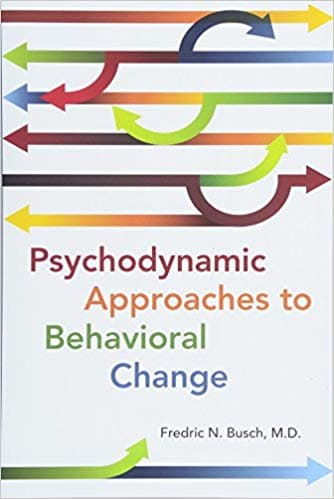Psychodynamic Approaches to Behavioral Change by Fredric N. Busch, MD
Analytically oriented (or psychodynamic) psychotherapy is a type of talk therapy. As a treatment, psychodynamic therapy focuses on the identification of factors that lead to problem behaviors and get in the way of change. Direct work on behavioral change, however, was traditionally seen as distupting neutrality and abstinence, two of the foundations of psychodynamic technique. Dr. Busch’s book, Psychodynamic Approaches to Behavioral Change (APA Publishing, 2019), details ways in which psychodynamic therapy is uniquely positioned to help people change their behavior. Dr. Busch demonstrates that many patients require more than insight - one of the main “therapeutic engines” of psychoanalysis. Dr. Busch’s book details the underpinnings of why analytically oriented therapist historically avoided “suggestion” to promote behavioral change. He recognizes that there are risks of attempting to address behavioral change (for instance, adverse impact on the therapeutic relationship, having only the patient’s perspective, and countertransference factors). However, Dr. Busch discusses how psychodynamic psychotherapy is uniquely positioned to address these risks. He elucidates elements of the psychodynamic formulation (development, trauma, self and other representations, conflicts, defenses, personality difficulties, deficits in mentalization skills) that the dynamic psychotherapist can create to assist the patient.

Psychodynamic Approaches to Behavioral Change
Dr. Busch reviews techniques (free association, clarification and confrontation, interpretation, development of mentalization skills, working through, and use of countertransference) that can help promote behavioral change. He builds and describes a framework for targeting behavioral change that includes making use of homework. Dynamic therapy can more effectively identify contributors to problem behaviors, for instances through the use of inference. Dr. Busch show how the process of identifying alternative behaviors can be integrated into therapy (which is a significant departure from traditional psychodynamic therapy). The technical portion of the books ends with 1. how to help patients sustain behavioral change and 2. how to help patients deal with the responses of others. The final two chapters illuminate specific situations that a therapist will experience when targeting behavioral change in dynamic therapy. The penultimate chapter focuses on specific, frequently encountered behavioral problems. The final chapter reviews recommendations for addressing behavioral problems related to adverse developmental experiences and trauma.
The book is impressive. It transitions from being a technical guide, to demonstrating examples, to advice on specific problems and a specific patient population.
I have taught two lectures to medical students and psychiatry residents based on the material from this book and I received positive feedback about the content. One resident told me, between the first and second lecture, that they had already successfully used one of the techniques in the book! In my private practice, the book has been a welcome addition to the collaborative work I do with my patients.
Highly recommended for both cognitive behaviorally (CBT) and analytically oriented therapists.
